Citrus trees, jade plants, and many other indoor plants when moving outside to get better sunlight each summer. Once they moved back to interior spaces, indoor plants fell victim to outdoor insect pests like mealy bugs on plants. These pests suck plant sap or chew on foliage and pose a severe challenge to owners in managing them? Furthermore, these outdoor pests spread over other indoor plants. One such difficult outdoor pest is mealybugs. Let’s discuss how to control mealy bugs on plant effectively.
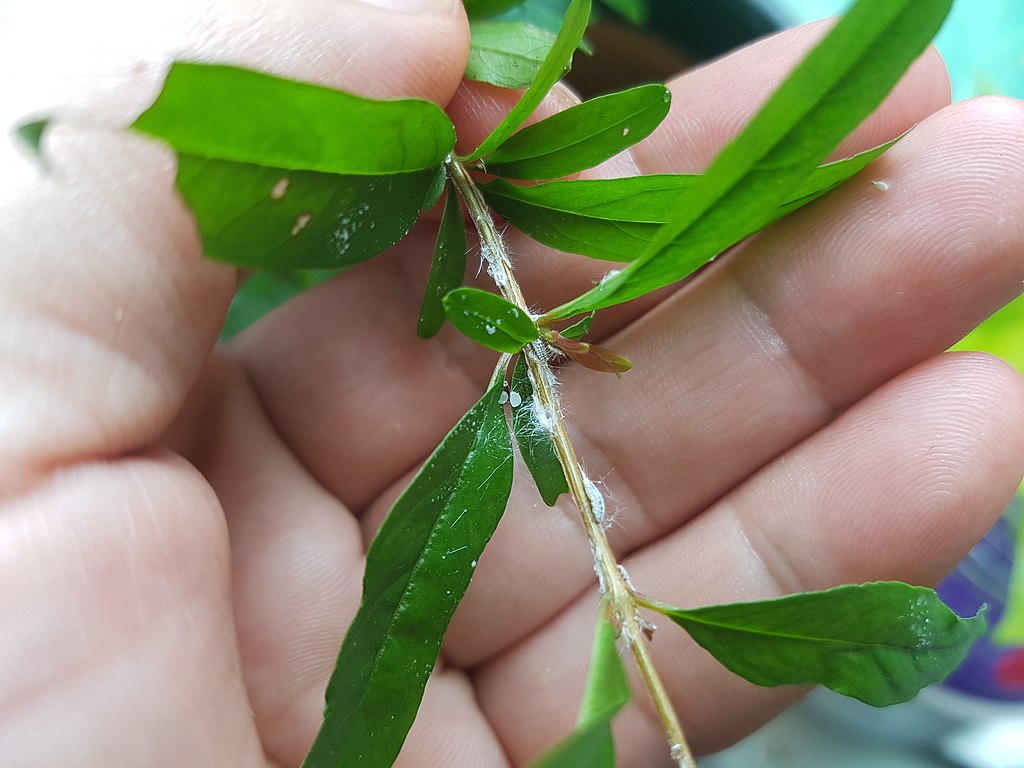
Multiple generations of mealy bugs on host plant
Mealybugs are mainly the outdoor pests that infest the houseplants during warm and dry weather and multiply rapidly. There are many ways to treat them, but organic and inorganic methods provide effective results.
It appears as a white fuzzy substance of the leaves and tender seedlings of host plants. They remain attached to the leaves and stems of infested plants during summer.
This write-up, “mealy bugs on plant,” will shed light on these sap-sucking pests, their identification, and how to treat them.
What Are Mealybugs?
Mealybugs are tiny, oval-shaped, sap-sucking pests that are a severe problem for indoor and outdoor plants. They feed in large colonies and are closely related to the scale insects with no hard coverings. However, mealybugs have a waxy coating with a cottony appearance.
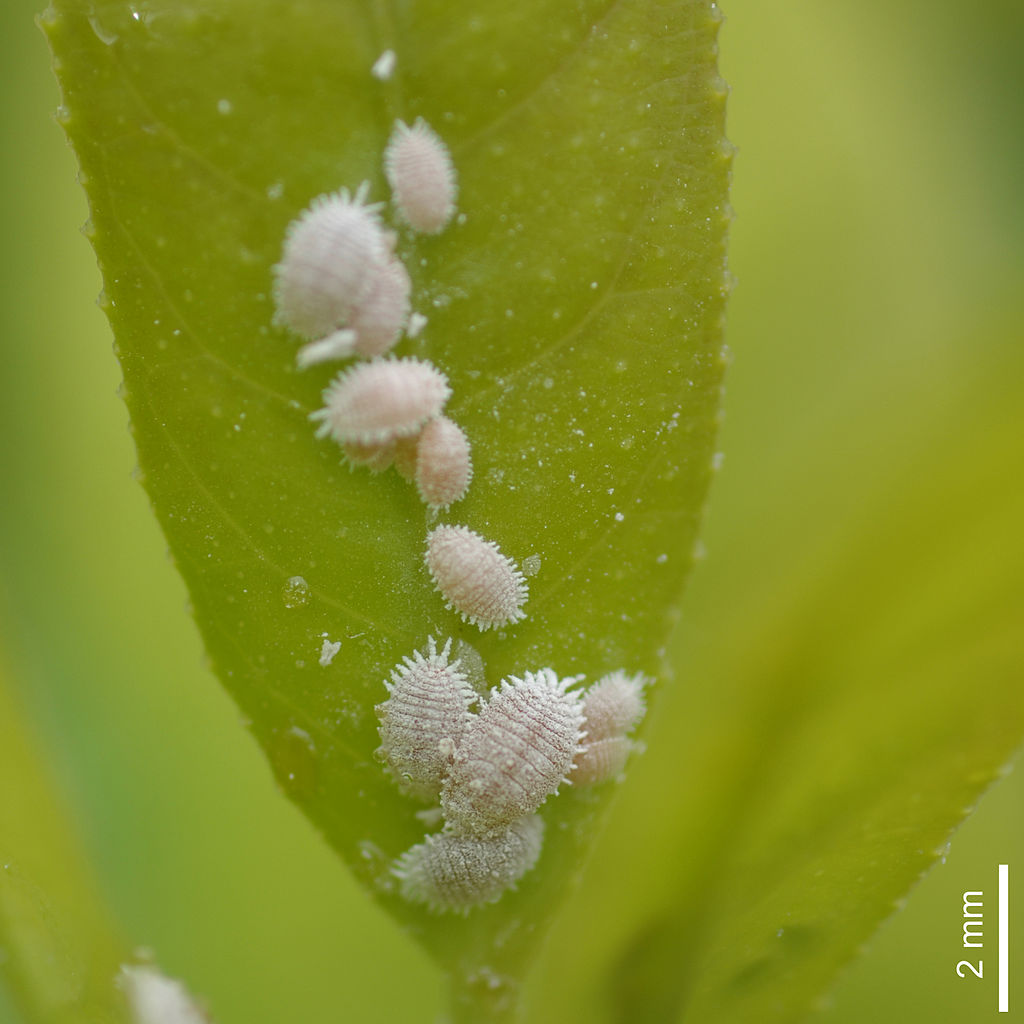
Adult and young mealybugs on host plant leaf
Like scale insects, mealybugs also secrete honeydew on the leaves of heavily infested plant parts. The sticky substance, as a result, supports the growth of black sooty mold fungus and black ants.
RELATED: What Are Mealybugs? How to Kill Them on Succulent Plants?
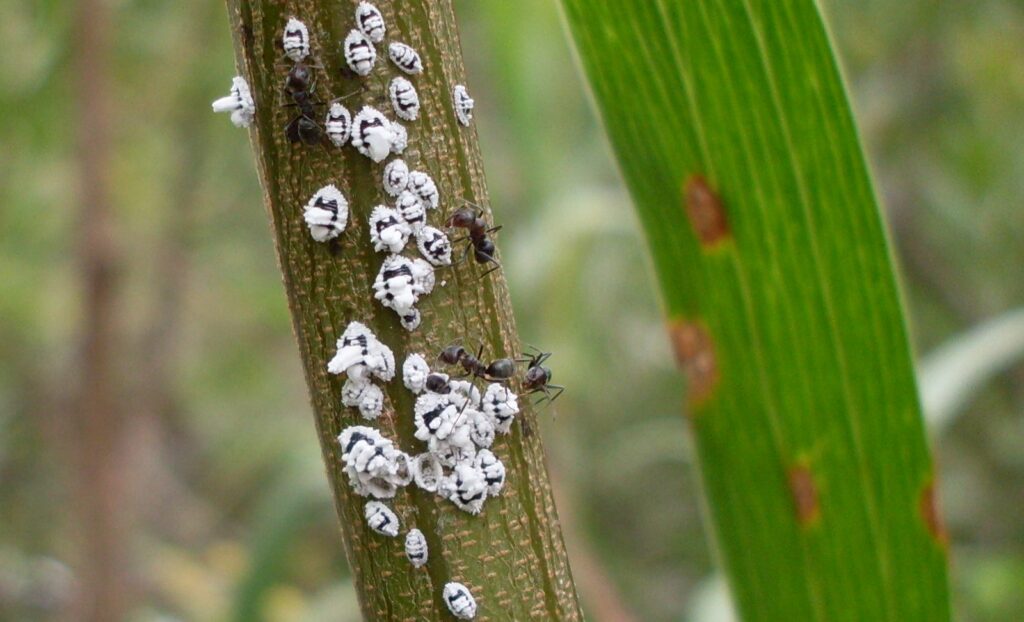
Mealybugs sucking out the sap of Sydney golden wattle
The image above indicates the feeding behavior of mealybugs. At the same time, they are busy sucking the juices from plant parts (Sydney golden wattle). On the other hand, the black ants are busy harvesting the sticky substance for themselves, secreted by mealybugs.
The leaf markings (irregular patches of brown color) represent the feeding damage of mealybugs.
The mealybugs suck out plant nutrients through long piercing syringe-like mouthparts (stylet) and cause significant damage in heavy infestations. At the same time, light infestations are not problematic for indoor and outdoor garden owners.
Identification of Mealybugs
Mealybugs belong to the insect family Pseudococcidae, which hosts insect pests of other plants such as scale insects (soft and armored scales) and cottony cushion scales.

A group of mealybug feeding on a hibiscus plant
They have distinct segmented bodies covered with a waxy coating. Heavily infested plants show cottony masses on leaves, weak growth, and stem cracks.
Mealybugs feed in large colonies, and all their life cycle stages can be seen on infested plants. They always provide protected plant parts where the leaves are touching and stem crotches.
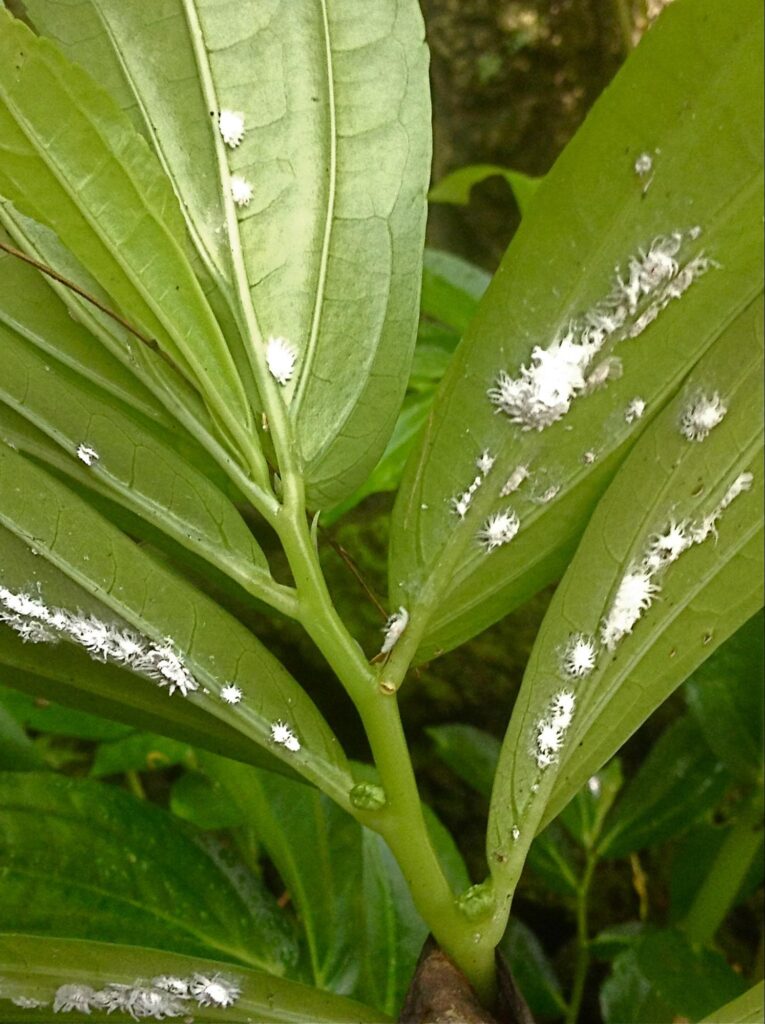
All the life stages (nymphs and adults) of mealybugs on heavily infested plant
The adults are 0.1 to 0.25 inches long and have long filaments around their body margins. Some species of mealybugs have only one or two large filaments at the rear end. The presence of these filaments helps in the identification of different species.
The youngs of mealybugs have a similar appearance to adults but vary in size. The nymphs also suck plant juices along with adult mealybugs.
Some Interesting Facts About Mealybugs
- Mealybug infestation confuses growers with scale insects
- They lack usual mouthparts; instead, mealybugs have long needle-like mouthparts—stylet to suck out their favorite nutrients from plant parts
- Mealybug undergoes incomplete metamorphosis, which means lacking the pupal stage
- The rate of reproduction is higher in mealybugs just like its close relatives (whiteflies, aphids, spider mites, and scale insects)
- Mealybugs have multiple generations per year
- They remain active throughout the year in indoor environments.
RELATED: What Are the Best Practices to Get Rid of Destructive Leaf Miners?
Host Plants of Mealybugs
These tiny pests have a more comprehensive host range and are difficult to detect because they hide in obscure places. The host plants for mealybug include citrus, croton, coleus, dracaena, English ivy, ficus, hibiscus, Fuschia, stephanotis, Schefflera, Mandevilla, gardenia, orchids, strawberry plant (houseplants), jade plant, palms, prayer-plants, and hoya.

Mealybug infestation on a jade plant—these tiny pests consider a favorite due to weak growth
On the other hand, the foliage host plants of mealybugs are marigolds, chrysanthemums, gerbera daisies, begonias, and poinsettias.

Another host plant with heavy numbers of mealybugs and black ants—the harvester of honeydew
Life Cycle of Mealybugs
The life cycle of mealybugs varies among different species. For example, some species of mealybugs lay eggs while others give birth to live young, such as long-tailed mealybugs.
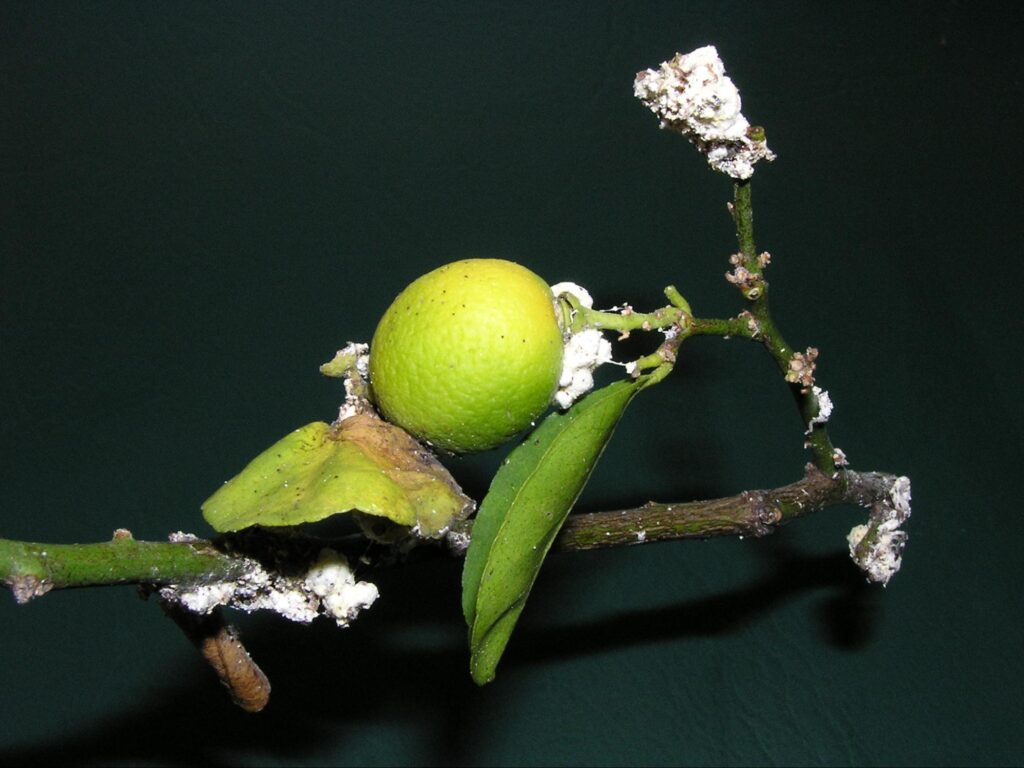
Mealybugs on citrus—the infested host has adult mealybug and their offspring. They are even more aggressive with new plants.
Mealybugs are active during the warm season of the year and reproduce incredibly. The females lay 200 to 300 eggs in a cottony sac over ten to twenty days. Egg masses are stored or hidden in stem cracks, the underside of leaves, and below the tree bark.
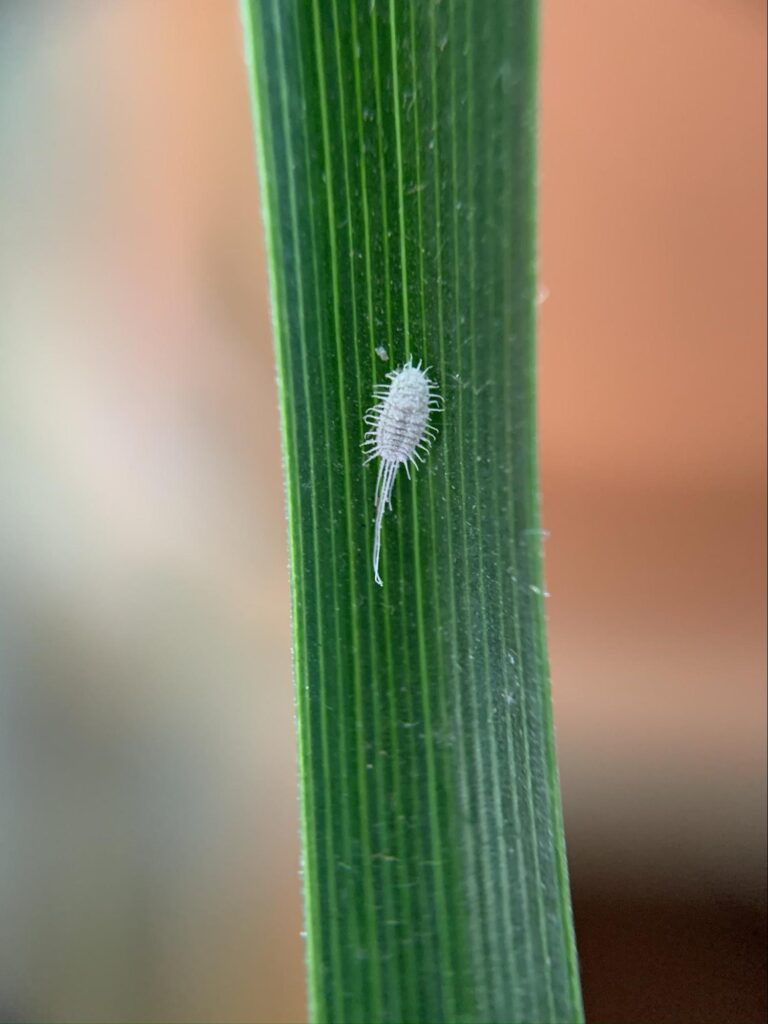
Long-tailed mealybug which gives birth to live young
Within three to seven days, the eggs hatch into young nymphs. The young crawlers appear yellow to pink and orange, lacking waxy covering. They are pretty active and search for suitable feeding sites.
Once they find the feeding sites, they establish themselves and secrete waxy coverings around their bodies. As they set, the young crawlers under three to four nymphal molt before becoming adults.
The female mealybugs are immobile, and the males have wings and fliers. Relying on weather conditions, mealybugs have six to eight generations pr year. In indoor spaces, they remain active all year round and have overlapping generations per plant.
In grapevine, mealybugs overwinter under barks and stem crotches in cold winters as egg sacs and adults.
How to Get Rid of Mealy Bugs on Plant?
Mealybugs are difficult to control, but the suitable approaches at early stages prove the best management. These tiny pests appear similar to scale insects and other problems such as aphids and whiteflies. It is because of the mealybug’s secretion of sticky material and the growth of black sooty mold.
Moreover, mealybugs hide in tree barks, stem pits, and other plants. Therefore, they go unnoticed during regular inspections.
Most importantly, prevention is vital.
- Regularly inspect the indoor and outdoor plants for white cottony material during warmer growing climates.
- Ensure the interior spaces around houseplants are neat and clean. Otherwise, mealybugs use it as hiding places, especially citrus mealybugs.
- Use yellow sticky traps to capture the flying adults and interfere with the mating process.
- Prune off the infested leaf joints, branches, leaves, and stems and discard them instantly.
- Remove older grandmother-type plants because they will act as a source of infestation.
- Check plant pots, stakes, and other materials for mealybug egg masses. If you find any infected plant parts, remove and dispose of them instantly.
- Use high-pressure water to wash off the adult and young mealybugs.
- To prevent mealybugs, avoid using excess nitrogen applications with regular watering because it will support the new growth of plants and egg production of mealybugs.
- Use mealybug-resistant plants in your interior and landscape spaces.
- Treat potting soil with diatomaceous earth and insect killer granules before planting houseplants.
The following approaches are the best for controlling mealybugs.
Encourage Beneficial Insects
The natural enemies of mealybugs are an excellent help for the management, such as parasitic wasps, green lacewings, and black lady beetle. These beneficial insects actively feed on mealybugs and destroy them.
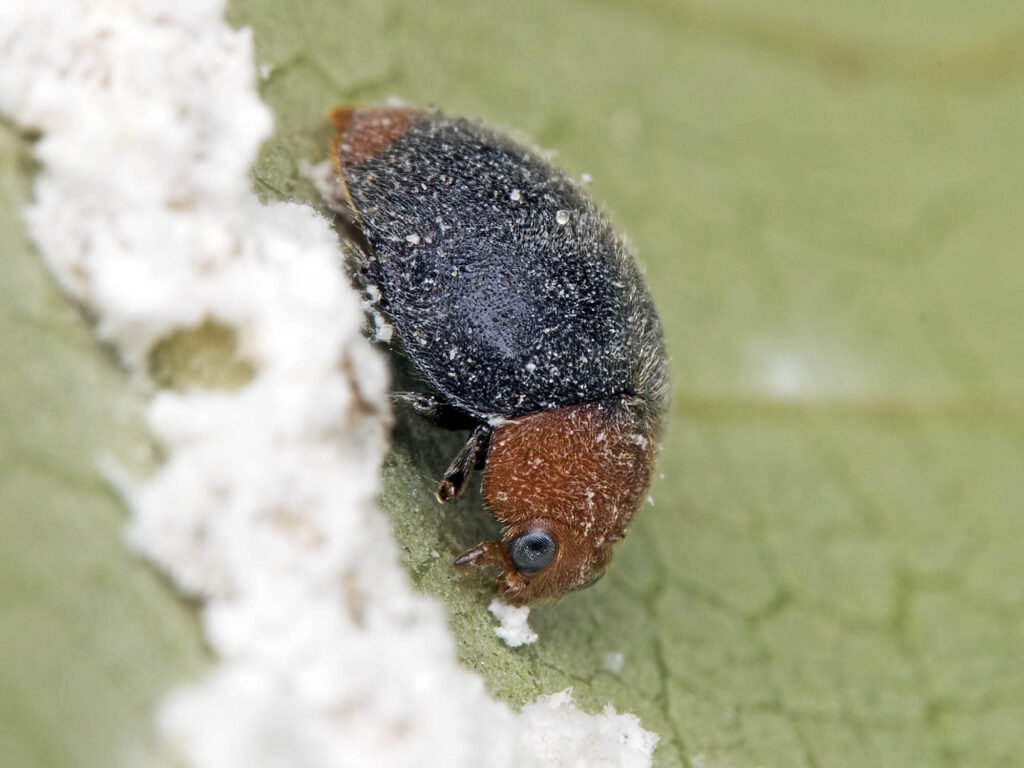
The Black lady beetle is feasting on mealybugs—the best natural predato
The parasitic wasps deposit their eggs in mealybugs and their nymphs. When eggs hatch, the larvae feed on host mealybugs and leave behind the waxy coverings.
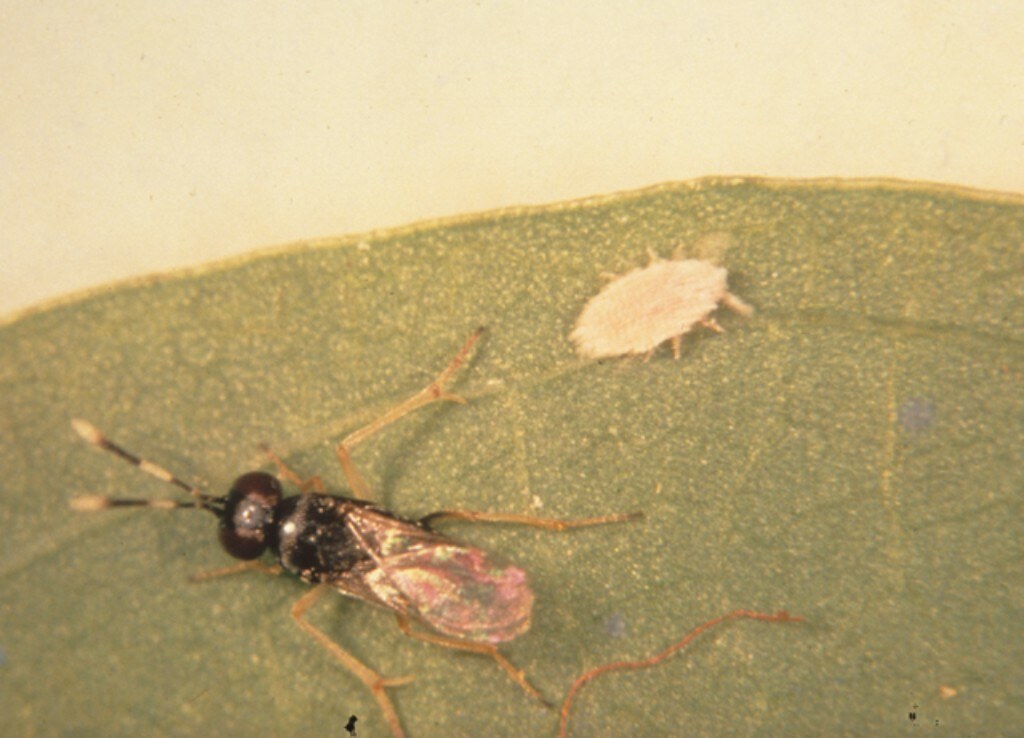
A parasitic wasp waiting for the right moment to attack cassava mealybug
Similarly, the black lady beetle actively feeds on mealybugs and keeps their populations under control. However, even the larvae of lady beetles mimic the mealybugs to invade and eat them.
Note: Do not spray broad-spectrum insecticides because they will harm the beneficial insects. Also, keep the black ants away from your garden and indoor spaces; otherwise, they will interfere with the eating process of natural predators.
Use Neem Oil to Treat Mealybugs
Neem oil spray is effective against a variety of insect pests. In addition, it disrupts the growth and development of insects. Best of all, it does not harm natural predators such as honey bees.
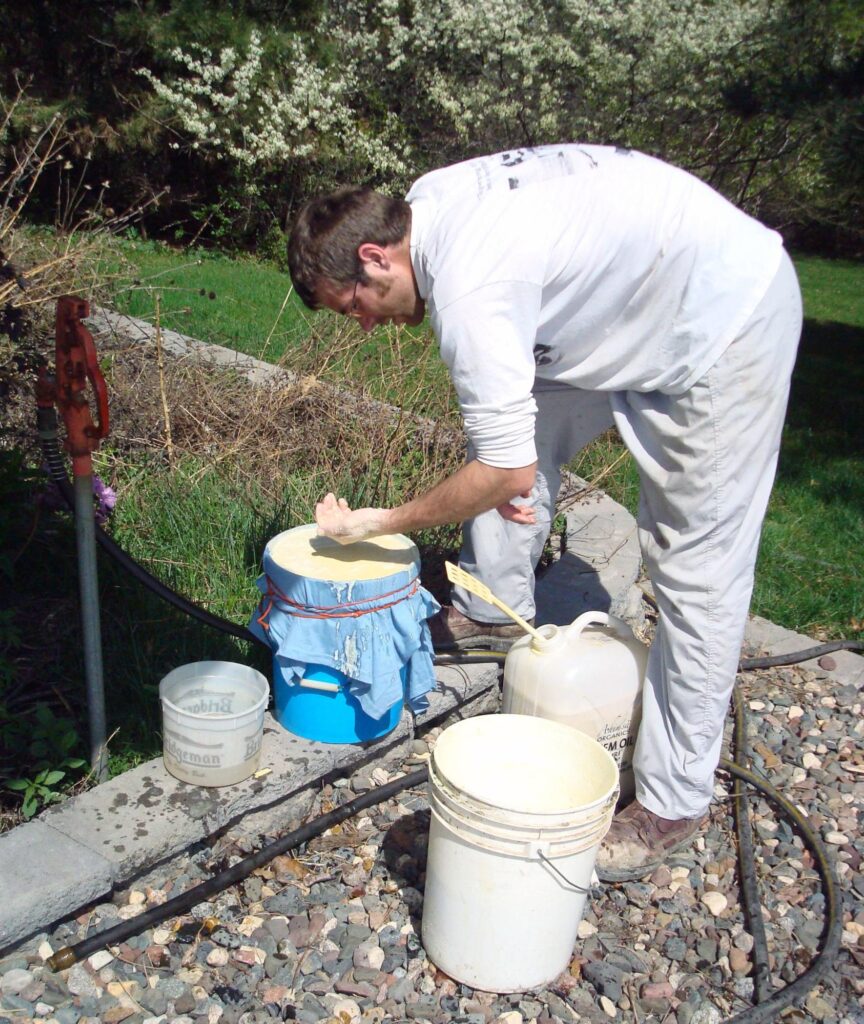
Neem oil spray preparation for the treatment of citrus mealybugs
Mix one tablespoon of neem oil per gallon of water combined with mild dish soap. Pour the mixture into a spray bottle and apply to the plant at 7 to 14 days intervals. It also functions as an antifeedant and suffocating agent.
Use Insecticidal Soap to Get Rid of Mealybugs
Insecticidal soaps are made up of the fatty acids of potassium salts. They puncture the outer covering of the insect body and cause dehydration.The application of these soaps combined with horticultural oils provides a win-win situation for growers against most species of mealy bugs on plants.
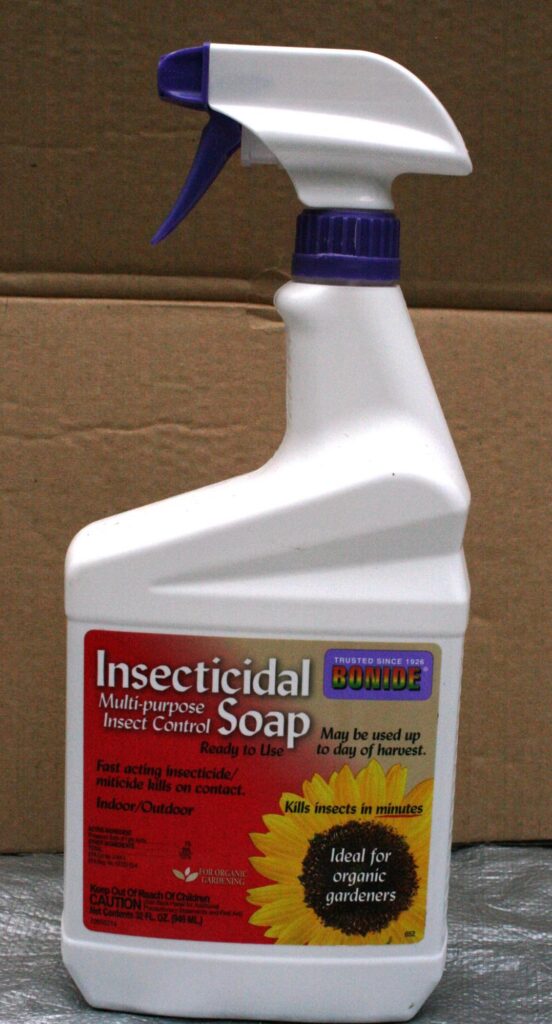
Spraying plants with insecticidal soap will prevent mealybugs
While applying to crops, make sure the whole plant is wholly saturated with soaps to kill mealybugs.
However, the root feeders are difficult to control with these organic sprays and need a more frequent application for work.
Rubbing Alcohol to Get Rid of Mealybugs
The organic treatments of mealybugs, sometimes, do not provide destruction. They feed in large colonies, hide in fallen leaves, and secrete waxy coverings that repel the contact insecticides. These factors make mealybug control impossible. Therefore, to treat mealybugs on houseplants, use a spot treatment with isopropyl alcohol.
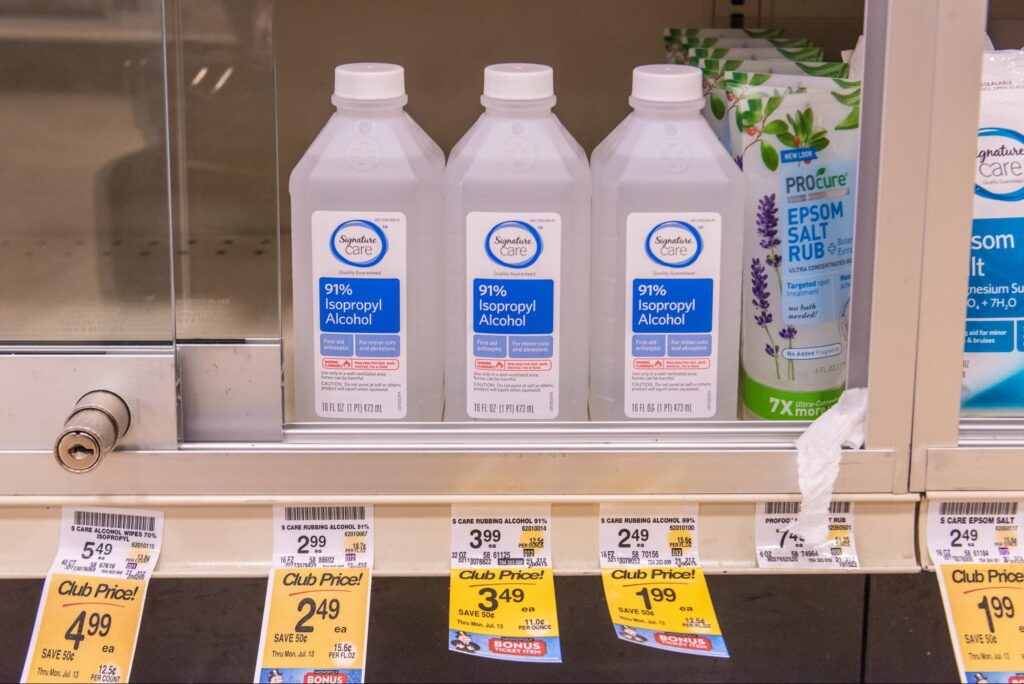
Employ spot treatment for the management of mealybugs
Mix one part of isopropyl alcohol with four pieces of water. Dab a cotton swab into the solution and rub on infested leaves to kill them. Before application, test plants to check for leaf burning. This procedure needs frequent application until the problem is gone.
Note: The effectivity of rubbing alcohol increases with horticultural oil.
Frequently Asked Questions
Can You Spray Succulents With Insecticide?
The applications of systemic insecticides on succulents containing dinotefuran and imidacloprid prove effective results. However, these insecticides make succulents toxic to harmful pests like mealybugs, aphids, whiteflies, and spider mites.
It is also wiser to reapply the systemic insecticides when re-poting them during the summer season. These systemic pesticides provide long-term protection against outdoor pests on succulents and decorate your interior spaces.
Do Mealybugs Live in Roots?
Yes, the belowground mealybugs are root eaters and challenging to control with chemical insecticides. They are soil-dwelling pests that voraciously feed on roots. Unlike their foliar mealybugs, they lack waxy coatings and large filaments.
How Do You Remove Mealybugs from Roots?
The root aphids can be controlled by hot water treatment. Dip the plant and roots in hot water for at least 10 minutes, and the temperature should be around 115° to 120℉. Sterilize the pots as well. This practice also removes the eggs and offspring of root aphids.
What Insecticide Kills Mealybugs?
The following insecticides are effective against mealybugs,
- Neem oil
- Horticultural oil
- Vegetable oil
- Imidacloprid
- Dinotefuran
- Pyrethroids
Will Vinegar Kill Mealybugs?
Vinegar spray will stop the molting process of mealybugs and reduce the population of explosion these pests. Mix one tablespoon of vinegar into four cups of water, pour into a spray bottle and spray on houseplants to kill these tiny sap-sucking pests.
Sources for Further Reading
- Bob Bricault, Michigan State University Extension. (2021, March 9). Mealybugs: A common pest of indoor plants. MSU Extension. Retrieved May 3, 2022, from https://www.canr.msu.edu/news/mealybugs_a_common_pest_of_indoor_plants
- Cranshaw, W. (2021). Mealybugs on Indoor Plants. University of Maryland Extension. Retrieved May 3, 2022, from https://extension.umd.edu/resource/mealybugs-indoor-plants
- Mahr, S. (n.d.). Mealybugs. Wisconsin Horticulture. https://hort.extension.wisc.edu/articles/mealybugs-2/
- Flint, M. L. (2016b). Mealybugs Management Guidelines–UC IPM. University of California Statewide IPM Program. Retrieved May 3, 2022, from http://ipm.ucanr.edu/PMG/PESTNOTES/pn74174.html
Now that you know how to control mealy bugs on plant, make sure to read our other tips on how to deal with plant pests:
Winter Moths: How to Get Rid of These Houseplant Enemies?
Effective Ways To Get Rid Of Russet Mites On Houseplants
What are the Best Practices to Get Rid of Thrips on Houseplants?







